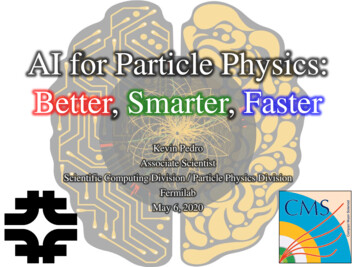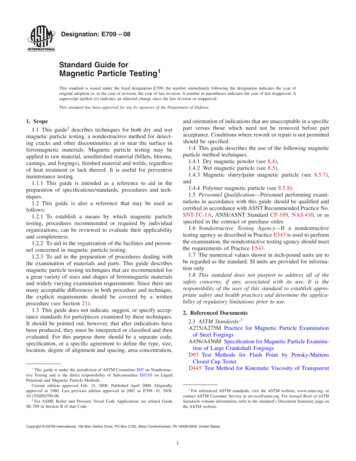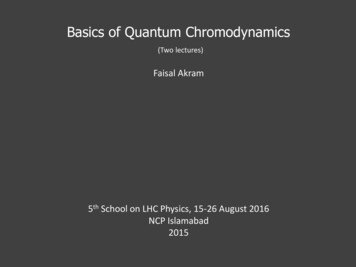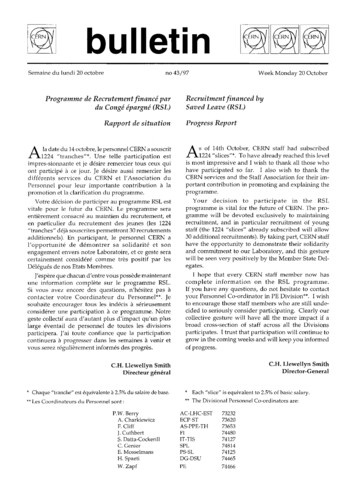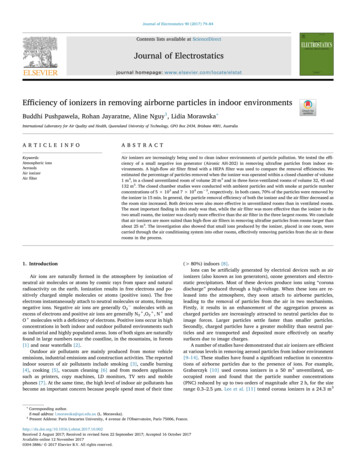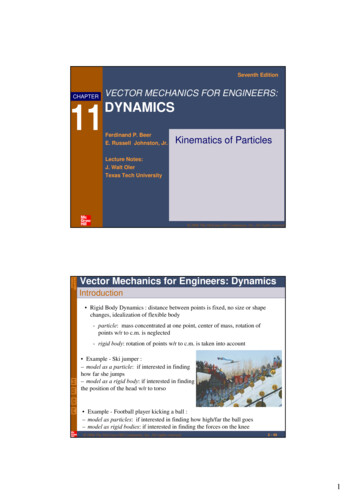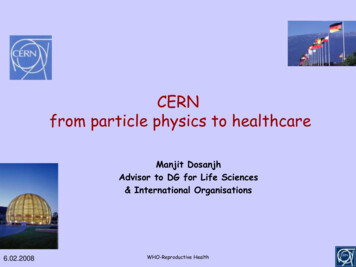
Transcription
CERNfrom particle physics to healthcareManjit DosanjhAdvisor to DG for Life Sciences& International Organisations6.02.2008WHO-Reproductive Health
CERN Seeking answers to questions about the UniverseAdvancing the frontiers of technologyTraining the scientists of tomorrowBringing nations together through science6.02.2008WHO-Reproductive Health
CERN in Numbers 2600 staff570 Fellows and Associates7000 users 6.02.2008Member States: Austria, Belgium, Bulgaria,the Czech Republic, Denmark, Finland,France, Germany, Greece, Hungary, Italy,Netherlands, Norway, Poland, Portugal,Slovakia, Spain, Sweden, Switzerland andthe United Kingdom.Observers: India, Israel, Japan, the RussianFederation, the United States of America,Turkey, the European Commission andUnescoWHO-Reproductive Health
Our view of the UniverseLHC?6.02.2008WHO-Reproductive Health
O-Reproductive Health
X-Rays, the fastest technology transfer example On November 8, 1895 Röntgendiscovered X-Rays On November 22, 1895 hetakes the first image of hiswife’s handRöntgen received the first Nobel prize in physics in 19016.02.2008WHO-Reproductive Health
MRI, Magnetic Resonance ImagingThe Nobel Prize in Physics 1952Edward M. PurcellPhysicist HarvardFelix BlochPhysicist StanfordThe Nobel Prize in Physiology or Medicine 2003Paul C.LauterburSir Peter MansfieldPhysicist Nottingham6.02.2008Chemist Uni.IllinoisWHO-Reproductive Health
Key Area Imaging detectors for diagnostics Accelerators for hadron therapy Isotope production GRID applications for Health6.02.2008WHO-Reproductive Health
Bio-medical applications of CERN technologies Some properties of HEP apparatus Some properties of biomedical apparatus Objectives: Particle Physicist Objectives: Medical practioners Highest possible performance Lab environment/physicist operated Possible complex maintenance Possible complex operation Single unit production Non commercial Industry as a manufacturer only Networked devices, specialist online Robustness Non-specialist operated Minimal maintenance Simple to operate Small series production Commercial distribution Industry as a partner .6.02.2008WHO-Reproductive Health
Physics to medicineIdea of PETPhoton detection used for calorimetryPETtoday6.02.2008WHO-Reproductive HealthCMS calorimeter
Inject Patient with Radioactive Drug Drug is labeled with positron( ) emitting radionuclide. Drug localizes in patient according tometabolic properties of that drug. Trace (pico-molar) quantities of drugare sufficient. Radiation dose fairly small( 1 rem).Drug Distributes in Body6.02.2008WHO-Reproductive Health
PET: true eventsNeutron-deficientisotopenn e epn p npp p npnDetectorpositron range511 keV annihilationphotone e- 180oDetector6.02.2008511 keV annihilationphotonWHO-Reproductive Healthtrue coincidences (T)(signal)
Similar challenges for PET and HEP detectors– New scintillating crystals and detectionmaterials– Compact photo-detectors– Highly integrated and low noise electronicsHEP Calorimeter– High level of parallelism and event filteringalgorithms in DAQ– Modern and modular simulation software usingworldwide recognized standards (GATE)PET Camera6.02.2008WHO-Reproductive Health
Crystal Clear Collaboration-New scintillators :-LuAP, phoswich LuAP-LSO (CERN patent)other crystals- new photodetectors (Avalanche PhotoDiodes)-new low noise front end electronics-new intelligent DAQ systems with pipeline and parallelizedarchitecture-better simulation GEANT 4-- better reconstruction algorithms6.02.2008WHO-Reproductive Health
1- CrystalsCMS PbWO4 production6.02.2008Crystal Clear LuAP productionWHO-Reproductive Health
The ClearPETLYSO/LuYAP Phoswich ScannerTMA high Performance Small Animal PET SystemHigher efficiency better spatial resolutionThe Design 20 detector cassettes on the ring each cassette has 4 PM in line each PM has 64 photocathodes each photocathode reads 1 phoswich each phoswich has 2 crystals LYSO and LuYAP each crystal is 2 x 2 x 10mm³ open gantry diameter adjustable 120 - 240mm rotation 360 degreeT cosine resolution 2 ns FWHNSpatial resolution 1.5 mm at centrePeak sensitivity 4%6.02.2008By Courtesy of Raytest, GermanyWHO-Reproductive Health
Positron Emission MammographyCRYSTAL CLEAR CollaborationModel of the PEM detectorDedicated breast PET detector allowinghigh sensitivity to the small tumordetection Spatial resolution 1-2 mm High counting sensitivity Short PET exams Compatible X-Ray mammography Compatible stereotactic biopsyTechnical characteristics: 6000 crystals 2x2x20 mm Avalanche Photodiodes (APD) Low noise electronics High rate data acquisition Spatial resolution 1-2 mm Breast and axila region6.02.2008WHO-Reproductive Health
What is Medipix?The Medipix is an electronic chip similar to the electronicimaging chip in a digital camera. One difference is that theMedipix chip is sensitive to xrays instead of visible light.What is unique about the Medipix chip is that it can createthe first true colour images with x-rays. Thus, it permits usto move from black and white x-ray images to full colour xray images. The chip also can be read out very rapidly. Thisallows the use the chip for colour x-ray digital movies or forfast colour x-ray CT scans6.02.2008WHO-Reproductive Health
MEDIPIX: Allows counting of single photons in contrast totraditional charge integrating devices like film or CCD High Energy Physicsoriginal development:Particle track detectors Main properties:Fully digital deviceVery high space resolutionVery fast photon countingGood conversion efficiency oflow energy X-rays6.02.2008WHO-Reproductive Health
Applications using Medipix2 Applications: Adaptative optics, X-ray diffraction, Micro-radiography, Neutron imaging, Computed tomography, Autoradiography,Gamma imaging, Electron microscopy, energy weighting, In vivo optical and radionuclide imaging, Micro-patterned gas detectors,Mammography X-ray image of a house fly (CERN)Electron microscopy: Rotavirus with 1.6 (left) and 160(right)e-/pixel, equivalent to: 0.04 e- /Å2 at specimen (left) and 4e- /Å2 (right) (MRC, Cambridge)Micro-radiography: Assembled radiographof a termite. Real size of the image isapproximately 1.4 mm x 1.7 mm (IEAP,Prague)Neutron imaging: Photograph and tomographic 3D reconstructionsof a tooth /www.cern.ch/MEDIPIX
5- SimulationHiggs event at LHC (CMS) with Geant4 ClearPET with GATE: Geant4 Applicationfor Tomographic Emission6.02.2008WHO-Reproductive Health
Multi-modality imagingPrimary lung cancer imaged with the SMART scanner.A large lung tumor, which appears on CT as a uniformlyattenuating hypodense mass, has a rim of FDG activityand a necrotic center revealed by PET.6.02.2008WHO-Reproductive Health
Hybrid machines:Philips: PET/CTGE: SPECT/CT6.02.2008WHO-Reproductive Health
Use of Accelerators for cancer treatment6.02.2008WHO-Reproductive Health
CancerIdeal cancer treatment would be to eliminate all tumour cellswithout affecting any normal cellsPhysics : 100% of the dose on target0% of the dose in surrounding healthy tissues or critical organsBiology : differential effectkill 100% of cancer cells"protect" normal cellsRadiation Therapy is non-invasive, has short-term side effects and isused to cure about 50% of all cancers with 5% of the totalcancer treatment budget6.02.2008WHO-Reproductive Health
Radiotherapy in the 21st Century RT is, nowadays, the least expensive cancertreatment method There is no substitute for RT in the near future The rate of patients treated with RT will likelyincrease in the years to come(Acta Oncol, Suppl:6-7, 1996)
Hadrontherapy vs. radiotherapy Tumours close to critical organs Tumours in children Radio-resistant tumoursPhotons and Electrons 6.02.2008Physical dose high near surfaceDNA damage easily repairedBiological effect lowerNeed presence of oxygenEffect not localisedvs.Hadrons Dose highest at Bragg PeakDNA damage not repairedBiological effect highDo not need oxygenEffect is localisedWHO-Reproductive Health
Considerations for ion beam treatment 6.02.2008Deep seated tumourHypoxic tumourTumour close to critical organ(s)Tumour in young childrenWHO-Reproductive Health
Comparative Treatment Planning: LargeSkull Base Chordoma4 photon fields with x-rays6.02.20082 fields with carbon ionsWHO-Reproductive Health
The PIMMS Collaboration Collaboration was formed in 1996 following an agreementbetween Med-AUSTRON (A) and TERA (I) CERN agreed to host and support the study in PS-Division The study was later joined by ONKOLOGY 2000 (CZ) Close contacts were kept with GSI (D) Work started in January 1996 and continued for 4 years. Final report is now available (CD ROM;CERN Yellow Report)6.02.2008WHO-Reproductive Health
PIMMS at CERN in 1996 - 2000CERN–TERA–MedAustron Collaboration for optimizedmedical synchrotronlinacs forcarbon ionsand protons400 MeV/u synchrotronpRF cavitySextupole vert.chromaticityBetatroncore6.02.2008CCSextupole horiz.chromaticityC 76.84 mQx 1.67Qz 1.72Sextupole eCircumferenceTune horizontalTune verticalSextupole horiz.chromaticitypProton and Ion Medical Machine uctive Health
5. In-beam-PET for Quality Assurance oftreatmentsMC simulatedmeasuredOn-line determination of the dose deliveredFirst time in 110 years!Modelling of beta emitters:Cross sectionFragmentation cross sectionPrompt photon imagingAdvance Monte Carlo codes6.02.2008WHO-Reproductive HealthIn-beam-PETGSI- Darmstadt
Hadrontherapy goals Provide the irradiation technology and thedetection systems to optimally use theadvantageous properties of heavy chargedparticles in external radiotherapy Optimize dose to tumour conformity bybeam scanning and adaptation of the deliveryto the organ motion Treat patients and perform clinical trialsusing low-LET (p, He) and high-LET (C, O)beams Conduct technical, physical and clinical R Dorgans atrisktumourtumour-conformaldose distribution6.02.2008WHO-Reproductive Health
ENLIGHT: European Network for Light Ion TherapyCreation of common interdisciplinary environmentDefine and Collaborate in areas needing further research at theEuropean levelProfit from each others experience in building, managing,operatingReduce Duplication, Increase Quality, profit from best ideas,concepts Creation of maximum possible uniformity Inter-facilities uniformity and comparison Ease of exchange of information.6.02.2008WHO-Reproductive Health
Production of isotopes6.02.2008WHO-Reproductive Health
6.02.2008WHO-Reproductive Health
Terbium produced with 1 GeV protons ISOLDETumourNo tumour aftertreatment with149TerbiumExperimental evidence of theusefulness of immunoconjugates formicro-metastasesISOLDE allows the production of novel isotopes6.02.2008WHO-Reproductive Health
Grids and e-health6.02.2008WHO-Reproductive Health
LHC data challengeConcorde(15 Km)CD stack with1 year LHC data!( 20 Km) 40 million collisions per second After filtering, 100 collisions of interest per second 1010 collisions recorded each yearMt. Blanc(4.8 Km) 10 Petabytes/year of data 10 000 times the world annual book production, 20km CD stackCMS6.02.2008LHCbATLASWHO-Reproductive HealthALICE
The Web Was a response to the needs of a distributed collaboratingcommunity And saved time and effort infetching information from other places It made sharing information so much easier Transparent access to information Independent of and removing barriers of space and time6.02.2008WHO-Reproductive Health
The GRIDThe Aim of the GRID is to give access,again easily and transparently,Not only to simple information,But also to all of the computing resources and storage distributed around theworld6.02.2008WHO-Reproductive Health
The User connects to his “Virtual Laboratory”or “Workbench Environment”Mobile AccessSupercomputer, PC-ClusterGRIDWorkstationMIDDLEWAREData-storage, Sensors, Experiments,Grid enabled ApplicationsInternet, networksVisualising6.02.2008Integrating framework middlewareWHO-Reproductive Health
MammoGrid Objectives Acquisition of large sample of mammograms Standardization of mammograms Annotation of mammograms by humans as well as CADesoftware Distributed data management system, cross-institute,cross-country queries Sharing of computing resources for the purpose ofoptimizing data storage and execution of computingintensive algorithms Proof of concept with active clinical participation6.02.2008WHO-Reproductive Health
MammoGRIDA pan-European distributed database ofmammography images using GRID technologies To manage health care informationfor screening To assist health operators in theirwork environment and exchangedata and practices To integrate latest technicaldevelopments in clinical practices 2 Main pilot applications:– CADe for quality controls(DICOM standards,GRID compliant,SMF Software)– Breast Density measurementsAt work at Cambridge Hospital32 MB / Image 2 x 2 images: 128MB per visit400 TB / year of information to be preserved for UK screeningBreast tumours: 24% not visible at screening, 80% of biopsies are negative6.02.2008WHO-Reproductive Health
eDiaMoND ProjectMammograms have differentappearances, depending on imagesettings and acquisition e Grid links a large federated databaseof normalised digital mammogramsshared initially by 4 ive Health3D View
Health-e-Child on a slide6.02.2008WHO-Reproductive Health
Observers: India, Israel, Japan, the Russian Federation, the United States of America, Turkey, the European Commission and Unesco . 6.02.2008 WHO-Reproductive Health Our view of the Universe L H C? 6.02.2008 WHO-Reproductive Health . Concorde (15 Km) CD stack with 1 year LHC data! ( 20 Km) Mt. Blanc (4.8 Km) 6.02.2008 WHO-Reproductive .

